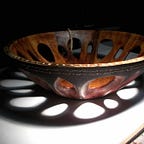ABSTRACT PAINTING: I Call it Playing with Paint
SGHolland 2017
Four years ago in September I was playing in the studio with large format water media and ink.
The series I was working on I came to call Canyons. Or in the case of one painting which could be enjoyed upside down, Regatta. But mostly it was about playing with paint. Water media on large sheets of wonderful watercolor paper. The effects of gravity, wetness, absorbency, color mingling, and even adding things like salt or rubbing alcohol came into this experiment.
It’s always with a backward glance at Tyler School of Art when I intermix media. So much was taught about the science of painting — including longevity issues — that I always wonder if my professors are turning in their graves.
What good is an abstract painting, anyway?
The acceptance of abstract painting into the snooty world of Fine Arts was just happening — mostly in New York — when I was in college. And it had its growing pains. It was one thing to love Impressionism (which had had its own hard knocks in the art world) with the shimmering, blurry renditions of real subjects. But the freedom bought by impressionists of the turn of the century got creatives playing with the art materials.
Pollock and those other Bohemians were dribbling paint on to rug-sized canvases, and Rothko was making huge color studies with hardly any shape but stripes! What were they thinking???
Planning out a realistic painting takes a lot of thinking, and Pythagoras had theorems that were quite specific and revered through the ages as the basis of good design. The guidelines for classical fine arts were drawn by the Old Masters and often rigidly held onto by serious art experts.
How to paint was an engineering project as well as skill with the paintbrush.
There were rules!
When did we decide that it was fun to look at a pile of paint put on a canvas that had no recognizable objects in it? Why would we think a certain shaped blob was beautiful to look at?
Think for a moment of a cobbler
feeling a piece of leather. He relates to that stuff. It’s what he handles all the time and there is beauty about the behavior of leather.
And think of the way a baker experiences a chunk of dough.
It’s beautiful! Beautiful things can and will come of it.
And the way a vintner savors a sniff of fine wine. It is the substance that excites him — anticipation of taste. The nose.
Painters come to love their materials in the same way. The way the brush touches the canvas — the way the paint moves onto the surface. The way the edges of a stroke look. How things blend or contrast. The character of the interactions between parts of the painting. The “feel” of it, emotionally.
The essence of a “good” painting is how the paint is applied and where — a viewer can decide if it works beautifully for him or her. A painting is deemed “not good” if it doesn’t reach out to a viewer. I might hate it and you might love it. The same painting might reach out strongly to the same viewer on a different occasion. Or something you used to love begins to look “not good” because you stop liking certain things about it — it has grown stale. No longer fascinating. The painting doesn’t change — the viewer does.
Are the strokes creamy or crisp? Are they fun to look at? Do they surprise? Do the colors evoke a mood? Do they make the viewer happy or sad? Do they engage the viewer? Whether it’s a Gainsborough or a Rothko, the viewer looks at the material and how it goes on the painted surface. The viewer gets to imagine the painter playing with the materials that day the marks were made. Sometimes the genius is locked in the physical piece of work and cannot be seen in a reproduction. Texture of paint and surface are part of it.
What I am getting at is that abstract art is essentially a glorification of the experience the artist has had with those particular materials at a specific moment in time. What is left is for the viewer to engage with.
So, when I look at my Canyons of four years ago I am a viewer. The paint is dry and the moment is over. But what remains has story and life, at least to me. And I enjoy seeing the colors and the ways the ink and the watercolor have interacted with the paper because of how I applied or manipulated it. It holds my interest. I may be the only one who enjoys it, actually. But, in fact, there surprisingly ARE others who are also interested in letting their eye roam around that painting and discovering the happenings of my canyon moment, I am glad to say.
Abstract art is about Experimentation. An adventure in a brand new moment.
Interestingly, much of the art of abstract is knowing when to stop! Your love affair with the media has its day in the sun and then there is the perfect time to stop! (When the soul smiles then it’s time to stop.)
Quirky stuff, isn’t it?
But art is like that. It is the fresh look — the novel moment — the moment of wonder that grabs the viewer. In all arts — the right combination of words, of tones, of volume, of timing — it is all like a kind of music, no matter which medium you work in. When it’s done, it’s out there for others to experience — however they may receive it.
Is it “good” art?
If you get to see it presented as art, the artist has decided it’s done.
If you are fascinated, entertained, curious, you may call it “good.”
©SGHolland 2017
